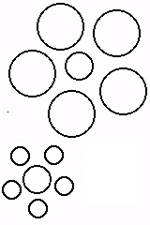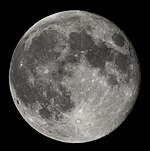Moon illusion
From Wikipedia, the free encyclopedia
| This article needs additional citations for verification. Please help improve this article by adding reliable references (ideally, using inline citations). Unsourced material may be challenged and removed. (May 2008) |
| This article includes a list of references or external links, but its sources remain unclear because it lacks inline citations. Please improve this article by introducing more precise citations where appropriate. (January 2009) |
The Moon illusion is an optical illusion in which the Moon appears larger near the horizon than it does while higher up in the sky. This optical illusion also occurs with the sun and star constellations. It has been known since ancient times, and recorded by numerous different cultures.
Contents |
[edit] Proof of illusion
A popular belief, stretching back at least to Aristotle in the 4th century BC, holds that the Moon appears larger near the horizon due to a real magnification effect caused by the Earth's atmosphere. This is not true: although the atmosphere does change the color of the Moon, it does not magnify or enlarge it. In fact, the Moon appears about 1.5% smaller when it is near the horizon than when it is high in the sky, because it is further away by up to one Earth radius and also because of atmospheric refraction, which makes the image of the Moon slightly smaller in the vertical axis. (Note that between different full moons, the Moon's angular diameter can vary from 33.5 arc minutes at perigee to 29.43 arc minutes at apogee — a difference of over 10%.[1])
The angle that the full Moon subtends at an observer's eye can be measured directly with a theodolite to show that it remains constant as the Moon rises or sinks in the sky (discounting the very small variations due to the physical effects mentioned). Photographs of the Moon at different elevations also show that its size remains the same.
A simple way of demonstrating that the effect is an illusion is to hold a small object (say, 1/4 inch wide) at arm's length (25 inches) with one eye closed, positioning it next to the seemingly large Moon. When the Moon is higher in the sky, positioning the same object near the Moon reveals that there is no change in size.
[edit] Possible explanations
In the Book of Optics (1011-1022 CE), Ibn al-Haytham was the first scientist to argue that vision occurs in the brain, rather than the eyes. He pointed out that personal experience has an effect on what people see and how they see, and that vision and perception are subjective. He came up with a theory to explain the Moon illusion, which played an important role in the scientific tradition of medieval Europe. It was an attempt to solve the problem of the Moon appearing larger near the horizon than it does while higher up in the sky. Arguing against Ptolemy's refraction theory, he redefined the problem in terms of perceived, rather than real, enlargement. He said that judging the distance of an object depends on there being an uninterrupted sequence of intervening bodies between the object and the observer. With the Moon however, there are no intervening objects. Therefore, since the size of an object depends on its observed distance, which is in this case inaccurate, the Moon appears larger on the horizon. Through works by Roger Bacon, John Pecham and Witelo based on Ibn al-Haytham's explanation, the Moon illusion gradually came to be accepted as a psychological phenomenon, with Ptolemy's theory being rejected in the 17th century.[2]
For over 100 years, research on the Moon illusion has been conducted by vision scientists who invariably have been psychologists specializing in human perception. After reviewing the many different explanations in their 2002 book The Mystery of the Moon Illusion, Ross and Plug conclude "No single theory has emerged victorious".[3] The same conclusion is reached in the 1989 book, The Moon Illusion edited by Hershenson, which offers about 24 chapters written by different illusion researchers.
It must also be kept in mind that people differ in how they experience the illusion (and some have no Moon illusion)[citation needed] so a single theory may not fit all people.
[edit] Angular size and physical size
The "size" of an object in our view can be measured either as angular size (the angle that it subtends at the eye, corresponding to the proportion of the field of vision that it occupies) or physical size (its real size measured in, say, metres). As far as human perception is concerned, these two concepts are quite distinct. For example, if two small, identical, and familiar objects are placed at distances of five and ten metres respectively, then the more distant object subtends approximately half the angle of the nearer object, but we do not normally perceive that it is half the size. Conversely, if the more distant object did subtend the same angle as the nearer object then we would normally perceive it to be twice as big.
A central question pertaining to the Moon illusion, therefore, is whether the horizon moon appears larger because its perceived angular size seems greater, or because its perceived physical size seems greater, or some combination of both. There is currently no firm consensus on this point.
Another theory is called point of reference. When the moon is near the horizon there are usually common objects in the foreground (trees, telephone poles etc.) that give a point of reference. Therefore the moon appears bigger next to an object for which the observer has a reference of size. As the moon travels higher in the sky the observer loses this point of reference for comparison therefore the moon appears to be smaller than when it is close to the horizon.
[edit] Apparent distance hypothesis
An apparent distance theory evidently was first clearly described by Cleomedes around AD 200. The theory proposes that the horizon moon looks larger than the zenith moon because it looks farther away.
When we see objects such as clouds, birds and airplanes in the sky, those near the horizon are typically further away from us than those overhead. This may result in the perception of the sky itself as a comparatively flat or only gently curving surface in which objects moving towards the horizon always recede away from us.
If we perceive the Moon to be in the general vicinity of those other things we see in the sky, we would expect it to also recede as it approaches the horizon, which should result in a smaller retinal image. But since its retinal image is approximately the same size whether it is near the horizon or not, our brains, attempting to compensate for perspective, assume that a low moon must be physically larger.
Extensive experiments in 1962 by Kaufman and Rock showed that a crucial causative factor in the illusion is a change in the pattern of cues to distance. (See Ponzo illusion, Depth perception, linear perspective, Texture gradient.) The horizon moon is perceived to be at the end of a stretch of terrain receding into the distance, accompanied by distant trees, buildings and so forth, all of which indicate that it must be a long way away, while these cues are absent from the zenith moon. Experiments by many other researchers have found the same result; namely, when pictorial cues to a great distance are subtracted from the vista of the large-looking horizon moon it looks smaller. When pictorial cues to an increased distance are added into the vista of the zenith moon, it appears larger.
A potential problem for the apparent distance theory has been that very few people (perhaps about 5%) perceive the horizon moon as being both larger and farther away. Indeed most people (perhaps 90%) say the horizon moon looks both larger and closer than the zenith moon (Boring, 1962, Hershenson, 1982, McCready, 1965, 1986, Restle, 1970). Also, most of the rest say it looks larger and about the same distance away as the zenith moon, with a few people reporting no Moon illusion at all. Those advocating the apparent distance hypothesis might counter that in the Ponzo illusion, people don't perceive one line to actually be farther away than another either, or that everything on the horizon is perceived as further away, out of the habit that this is true for every object even seen there (average-altitude clouds are about 100 times further away at the horizon than when overhead).
Nevertheless, the apparent distance explanation is the one most often found in textbooks.
[edit] Relative size hypothesis
Historically, the best-known alternative to the "apparent distance" theory has been a "relative size" theory. This states that the perceived size of an object depends not only on its retinal size, but also on the size of objects in its immediate visual environment. In the case of the Moon illusion, objects in the vicinity of the horizon moon (that is, objects on or near the horizon) exhibit a fine detail that makes the Moon appear larger, while the zenith moon is surrounded by large expanses of empty sky that make it appear smaller.
The effect is illustrated by the classic Ebbinghaus illusion shown at the right. The lower central circle surrounded by small circles might represent the horizon moon accompanied by objects of smaller visual extent, while the upper central circle represents the zenith moon surrounded by expanses of sky of larger visual extent. Although both central circles are actually the same size, to many people the lower one looks larger.
[edit] Oculomotor micropsia/macropsia theory
Oculomotor micropsia and macropsia are physiological effects in which the under- or over-focusing of the eye makes objects appear respectively smaller or larger.[4] A rough idea of the effect can be obtained by holding your hand a short distance in front of your face. When you switch focus from some distant object back to your hand, the distant object tends to appear smaller. (See convergence micropsia.)
As applied to the Moon illusion, this theory claims that when observing the zenith moon the eyes are "expecting" to focus at a "normal" distance of perhaps a few metres, due to the absence of distance cues. This expectation causes the brain to misinterpret the situation, even when no overt misfocusing occurs, and the zenith moon to appear smaller. The opposite effect occurs when viewing the horizon moon, when the horizon offers cues that the Moon is at a great distance.
[edit] Angle of regard hypothesis
According to the angle of regard hypothesis, the Moon illusion is produced by changes in the position of the eyes in the head accompanying changes in the angle of elevation of the moon.
[edit] References
- ^ Astronomy Picture of the Day — large and small full moons, NASA
- ^ (Hershenson 1989, pp. 9–10)
- ^ Helen Ross, Cornelis Plug (2002). The Mystery of The Moon Illusion. Oxford University Press, USA. Page 180.
- ^ "The Moon Illusion Explained", Don McCready, University of Wisconsin-Whitewater
[edit] External links
- A vision scientist reviews and critiques moon illusion theories (and argues for oculomotor micropsia).
- Another careful review of moon illusion research.
- A physicist unfamiliar with visual perception offers opinions about current theories
- Summer Moon Illusion - NASA
- Why does the moon look so big now?
- Explanation visual gestalt effects, which may also apply to the moon illusion
- Why does the Moon appear bigger near the horizon? (from The Straight Dope)
- #moonillusion Moon illusion illustrated
- Moon illusion discussed at Bad Astronomy website
- New Thoughts on Understanding the Moon Illusion
- Four Answers to the Why Question about the Moon Illusion
- Father-Son Scientists Confirm Why Horizon Moon Appears Larger
|
||||||||||||||||||||||||||




